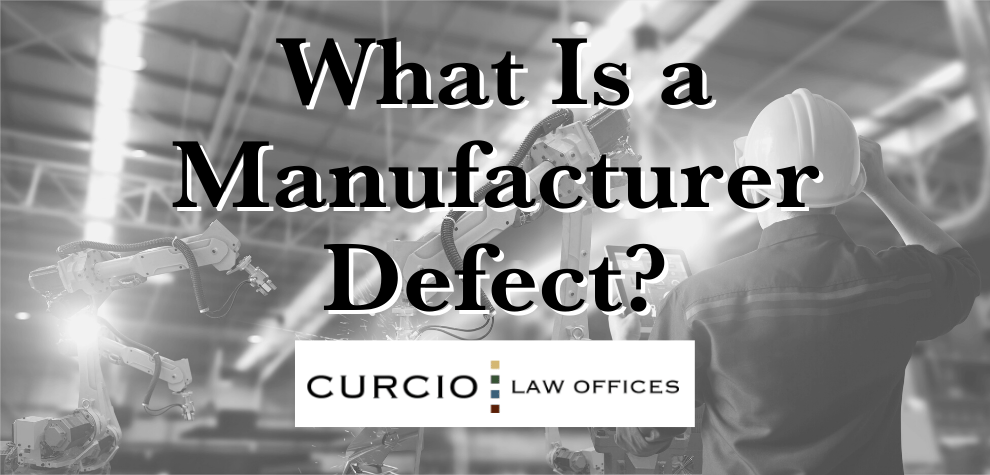Even the most well-thought-out products have the potential to harm consumers. When manufacturing defects occur in the manufacturing process, products deviate from the original production plan. As an example, think of prescription medications. At the processing facility, it is possible for the product to become contaminated. When a manufacturing defect occurs and a consumer gets hurt, the manufacturer is liable for those injuries.
If you suffered injuries as a result of a manufacturing defect, you need the experienced Chicago product liability lawyers at Curcio & Casciato. Our Illinois personal injury attorneys have years of experience in protecting consumers from dangerous and defective products. No matter the circumstances, we expect the products we buy to help us, not harm us. To schedule your free and confidential consultation, please call 312-321-1111 or fill out our online intake form.
Product Liability Law in Illinois
The legal duty of a product’s manufacturer, producer, distributor, merchant, or seller to reimburse an injured person when the product causes damage or personal injury to the customer, user, or spectator is known as product liability.
Manufacturers, builders, suppliers, producers, distributors, wholesalers, retailers, and commercial lenders, among others, can be held accountable for a product’s chain of distribution.
Depending on the type of product and the injuries that ensue, product liability law may be rather complicated. Illinois usually sees two primary legal theories surrounding a product liability lawsuit, which we list below.
Negligence Theory
Using this theory, product liability attorneys must prove the following elements of negligence.
- The defendant (manufacturer or seller) owes a duty of care to the person injured.
- The defendant breached that duty of care.
- That breach caused the injury which was foreseeable.
- The plaintiff (you) suffered an injury which is eligible for compensation.
A faulty product can be blamed on anybody in the distribution process, including the producer, assembler, and, in certain cases, the seller or retailer. The buyer, their family members, onlookers, or those holding or leasing the commodity from the first purchase may all be owed a duty of care.
Strict Liability
Using the strict product liability theory, sellers, manufacturers, or other parties in the chain of distribution could be held accountable for defective products when they harm a consumer. Plaintiffs must prove the following.
- The customer was injured as a result of a problem or flaw in the defendant’s goods, which was made or sold.
- The condition or flaw was hazardous in an unreasonable way.
- When the product left the manufacturer’s supervision, it had a problem or fault.
What Is the Statute of Limitations for Product Liability in Illinois?

Because product liability claims are subject to a statute of limitations, anybody who has been hurt as a result of the use of a faulty product must move promptly to obtain justice. In Illinois, the statute of limitations for product liability lawsuits in which a faulty product causes an injury is two years from the date of purchase. The statute of limitations for lawsuits involving property damage caused by the use of a faulty product is five years.
What Are Manufacturing Defects?
A manufacturing defect refers to a flaw in a product’s design or development that causes it to malfunction. The product departs from its original design, putting customers at risk of damage, injury, or death. Product liability law protects injured parties by granting them the right to pursue legal action.
Types of Defects

This category encompasses a large number of product liability cases. Product liability lawsuits, unlike other forms of injury claims, are responsibility without fault. This implies that a manufacturer does not have to behave intentionally or carelessly to be held liable by the courts. The following are some instances of common manufacturing flaws.
- Improperly manufactured materials, such as plastics
- Poorly installed electrical circuits
- Incorrectly attached parts
- Incorrect fasteners or bolts
What Causes a Manufacturer Defect?
Poor material quality and neglect are the most typical causes of manufacturing problems. When an object is built of low-quality materials, it is more likely to break down, putting the buyer in danger. Mistakes are easy to make if the maker does not pay attention and follows the right technique when manufacturing something.
This irresponsible action puts people in danger of getting hurt. Manufacturing flaws are also defined by the courts as a situation in which an item’s manufacture deviates from the original, intended design. This type of action is known as strict liability, and it holds the manufacturer liable for product liability and any future damages.
How Do You Prove a Manufacturing Defect?
As with any product liability case, evidence is key. However, there are four essential elements that can help you in a manufacturing defect situation.
- You were making proper use of the goods. One of the most important aspects of a successful lawsuit is demonstrating that you were not at fault for the product’s flaw or your personal damage.
- The product was faulty. You must demonstrate that a fault in the product was caused by a step in the process, from design through manufacture.
- You’ve been hurt or have been harmed in some way. It’s critical to establish that you were not just harmed, but that the injury caused you financial or emotional hardship in some manner, whether via missed income, medical expenses, or pain and suffering.
- You were harmed as a result of the product’s flaw. Finally, your lawyer must establish a strong link between the product defect and your injuries.
The Necessary Evidence
You’ll need essential proof to back up those four criteria if you can prove them. Certain types of evidence can help you make your case in a variety of ways. The following are examples of critical evidence.
- The product itself
- Evidence that the manufacturer knew about the defect, like emails or memos
- Payroll records and medical bills which account for the financial losses you suffered
- Videos or pictures of your injuries, the incident which caused them, or the defect in the product
- Accident report
- Expert and bystander witnesses
- Insurance policy documents
- Marketing materials for the product
- Labels from the product
What Is the Malfunction Doctrine?
According to the malfunction doctrine, a victim can show that a product is faulty without needing to depend on the product itself. While establishing that a product was faulty is important in a product liability action, it is not always attainable.
A plaintiff can, however, cite the product’s destruction as proof of malfunction under the malfunction theory. Once the plaintiff proves that the harm was most likely caused by a defective product, he or she might show that alternative sources of injury were implausible or impossible.
Call a Chicago Product Liability Attorney Today
If you suffered an injury, harm, or financial loss due to the use of a defective product, you may have a case. Contact the Chicago manufacturing defect attorneys with Curcio & Casciato for qualified legal representation. We handle a wide array of product liability claims, and we’re here to seek justice after your injuries. To schedule your free consultation, please call 312-321-1111 or fill out our online intake form.



